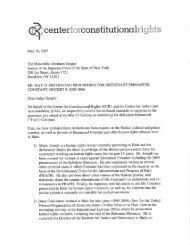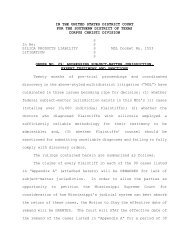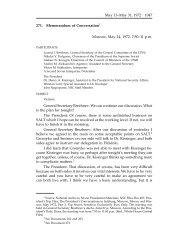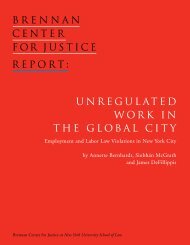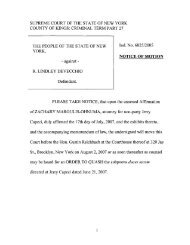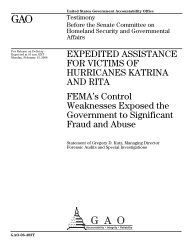Strengthening Schools by Strengthening Families
Strengthening Schools by Strengthening Families
Strengthening Schools by Strengthening Families
You also want an ePaper? Increase the reach of your titles
YUMPU automatically turns print PDFs into web optimized ePapers that Google loves.
New York City parents have also long complained of erratic<br />
and unpredictable school bus service. Children who take<br />
school buses tend to have lower rates of attendance than<br />
those who walk to school, because a child who misses a bus<br />
may have no other way to get to school, according to school<br />
officials. Special education students can be inexplicably<br />
assigned to schools on the other end of their borough,<br />
reports one Bronx family worker. And leaders in wheelchairaccessible<br />
schools, like Morrisania’s P.S. 132, note that<br />
disabled children are particularly vulnerable since they have<br />
no alternative to the school bus service.<br />
Another big effect on attendance may well be the most<br />
overlooked: the quality of the school. Both principals and<br />
parents will testify that cheerful, welcoming schools with<br />
engaging teachers have higher rates of attendance than<br />
gloomy, punitive schools—because the children want to be<br />
there. “It’s about the culture of the school,” says LaTrella<br />
Penny at Agenda for Children Tomorrow, a social services<br />
group which consults in the schools. “The school has to be a<br />
place that children want to come to.”<br />
how PrInCIPals get helP<br />
Responsibility for monitoring attendance rests almost entirely<br />
with the leadership of each school. In 2003, Chancellor<br />
Joel Klein effectively dismantled the old community school<br />
districts, each of which had a superintendent charged with<br />
monitoring attendance and deploying trained staff to assist<br />
schools with poor attendance rates. Today, attendance<br />
monitoring is done <strong>by</strong> a much smaller staff at the DOE’s<br />
central office and in the new, borough-wide Integrated<br />
Service Centers. They watch for problems and offer help to<br />
schools they see struggling, but the staff lacks formal power<br />
to intervene in an individual school’s operations.<br />
“Principals are like CEOs and they have been given a lot<br />
of flexibility in terms of making decisions,” says Lilian<br />
Garelick, the DOE official in charge of monitoring<br />
attendance. “We are here for support. It is up to the<br />
principals to say, ‘Well, OK, I have an issue.’”<br />
Many principals ask for help from the Integrated<br />
Service Centers and from their chosen School Support<br />
Organizations, which have the responsibility to help<br />
principals deal with problems like this. But principal<br />
turnover has been high under the Klein administration,<br />
and it takes time for principals to establish deep ties in<br />
a neighborhood or gain knowledge about child and family welfare issues. The staff at the Bronx<br />
Integrated Service Center, which helps principals deal with poverty issues, spends a great deal<br />
of time coaching on the basics of attendance, child safety, homelessness, behavior and health.<br />
Attendance patterns vary greatly as children proceed through their<br />
educational years. There are high levels of absenteeism in each of the three<br />
important transition periods: the start of elementary, middle and high<br />
school. These periods of dramatic change can be perilous for marginal<br />
students who may rack up absences quickly and �nd themselves falling<br />
behind. This chart shows that the Department of Education’s primary<br />
attendance warning system—the 407 attendance alert—fails to identify and<br />
warn schools about the full number of chronically absent students. It is up to<br />
the schools to develop systems sensitive enough to catch and respond to all<br />
chronically absent students. This may or may not happen, depending on the<br />
quality of leadership in the school.<br />
PERCENTAGE OF STUDENTS<br />
50%<br />
45%<br />
40%<br />
35%<br />
30%<br />
25%<br />
20%<br />
15%<br />
10%<br />
ATTENDANCE WARNINGS MASK THE<br />
TRUE NUMBER OF CHRONICALLY ABSENT<br />
STUDENTS IN THE LOWER GRADES<br />
COMPARING CHRONIC ABSENCE MEASURES PK–12<br />
5%<br />
0% PK K 1 2 3 4 5 6 7 8 9 10 11 12<br />
GRADE<br />
CHRONICALLY ABSENT: PERCENT OF STUDENTS WITH 20 ABSENCES OR MORE<br />
PERCENT OF STUDENTS ISSUED AT LEAST ONE 407 ALERT<br />
SOURCE: New York City Department of Education, requested data run from ATS, July 2008. Results<br />
include PK and all grades. Districts 75 and 79 excluded. Charter schools excluded.<br />
NOTES: This chart incorporates data from two comparable student attendance datasets, both run after<br />
year close of the 2007–2008 school year: Explanation of the datasets is provided below. There were<br />
marginal differences in the number of students reported in each dataset, but these were not statistically<br />
significant.<br />
FOOTNOTES: 1. Chronically absent is defined as missing more than 10 percent of the school year. In<br />
New York City, this is approximately 20 days or more of school.<br />
2. From Individual Student Attendance Data Set: Data was obtained using each student’s universal<br />
identifier number, assuring that their absences would be tracked properly if they changed schools within<br />
the school year. All absences are assigned to the school and district the student was attending at the end<br />
of the school year.<br />
3. From School Based 407 Alert Data Set: Data was obtained from the Department of Education’s<br />
“Form 407” attendance alert system. The DOE typically sends a 407 alert after a student has missed<br />
10 consecutive days of school, 20 days over a 40 day period or 8 consecutive days if there has been<br />
a previous 407 alert. <strong>Schools</strong> can lower these thresholds to be more aggressive on attendance.<br />
Most don’t, but some do.<br />
9




